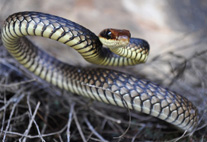Abstract
Molecular phylogenies have provided strong evidence for clarifying the taxonomy of groups with ambiguous morphological traits, thus avoiding potentially misleading conclusions based on evolutionary convergence of these traits. For snakes, established molecular databases along with new sequences from rare species allows us to estimate phylogenies, to clarify the phylogenetic relationships and test the monophyly of most taxonomic groups. Using one mitochondrial gene and five nuclear loci, we evaluate the taxonomic status of a rare Southeast Asian serpent, the Rainbow Tree Snake Gonyophis margaritatus (Squamata: Colubridae) by inferring a molecular phylogeny of 101 snake species. Both maximum likelihood and time- calibrated Bayesian inference phylogenies demonstrate that G. margaritatus is sister to Rhadinophis prasinus, previously considered to be part of a radiation of Old World ratsnakes. This group is in turn sister to a group containing Rhadinophis frenatus and Rhynchophis boulengeri with the entire clade originating in the mid-Miocene (~16 Ma) in Southeast Asia. This group is sister to the genus Gonyosoma and together originated in the early Miocene (~20 Ma). We discuss three potential solutions towards eliminating polyphyly of the genus Rhadinophis, but recommend using the genus name Gonyosoma for all species within this clade, which currently contains all of the species within the genera Gonyosoma, Gonyophis, Rhadinophis, and Rhynchophis.

